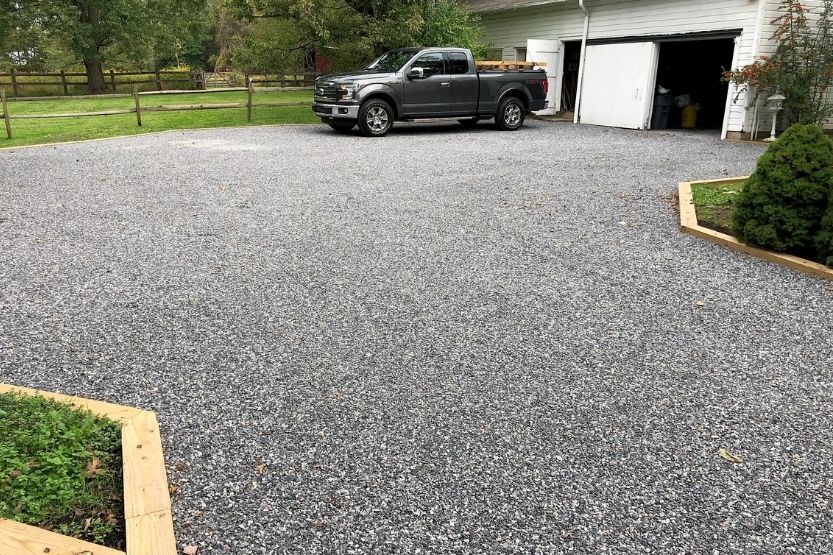Gravel is the cheapest material you can use for your driveway and walkway. If you construct and maintain them correctly, gravel pavements can also last long. Is there gravel that hardens like concrete?
Gravel that hardens like concrete is called hard pack gravel. This recycled material is compacted into a hard base but still provides drainage. The most common base material for hard-pack gravel is pea stone, about 3/8 inch or smaller.
Another type of gravel that can harden as concrete is self-binding gravel. This gravel type combines either 8 mm or 10 mm sized gravel particles, clay, and sand that bind firmly when compacted. It looks clean and attractive and is very easy to maintain.
Read on to learn more about gravel that can harden like concrete, its nature, how to harden it like concrete, and how to use it for driveways, walkways, and landscaping.
Gravel That Hardens Like Concrete

Hard Pack Gravel Is Compact Yet Provides Adequate Drainage
A type of gravel that can harden like concrete is hard pack gravel. It is a recycled base material compacted into a hard base but provides adequate drainage. Peastone (3/8 inch or smaller) is the usual base material for this gravel type.
Self-binding Gravel Is a Gravel, Clay, and Sand Mixture
Self-binding gravel is another type of gravel that can harden like concrete. It is a blend of either 8 mm or 10 mm sized gravel particles, clay, and sand that bind tightly when compacted together.
Neat and Attractive
When used for driveways and walkways, they look neat and attractive. It is also effortless to maintain, requiring only occasional weeding. It is a suitable alternative to the usual garden and driveway surfacing options.
Stay Firm Underfoot
When compacted, self-binding and hard pack gravels can stay firm underfoot. They can be almost as hard and solid as concrete. They are better in this respect than conventional loose aggregate surfaces.
More on Hard Pack and Self-Binding Gravel
Cheapest Driveway and Garden Surface Options
Hard pack and self-binding gravel are the cheapest driveway and garden surface options. Many people commonly use them as ground surfaces for public parks and parking lots. They are porous aggregate bound systems and high-performance sustainable drainage system (SuDS) compliant.
Can Exceptionally Withstand Wear
The surface of the gravels can exceptionally withstand wear. Their surface finish is also visually appealing. One thing that makes them cheaper to use is that they do not need any binding agent to hold the small pieces of gravel together.
Can Resist Erosion Due to Tough Surface
The sand, fines, and stones mixture forms a tough surface that resists erosion when compacted. That’s why you can see them in walkways, driveways, and roads. Because of their solid and hard nature, many people also refer to them as hard pack and ledge pack.
The hard packs and self-binding gravel based material is crushed stone number 8 or peastone. These stones are between 3/8 inch and 1/2 inches in size.
Size of Gravels Experts Use
Other gravel sizes that experts use in constructing roads and highways are the following:
- Number 5 – crushed stones that are about 1 inch or smaller
- Gravel Size Number 3 – crushed stone that are between 1/2 inch and 2 inches
- Number 1 – crushed stones that are between 2 and 4 inches. They are the largest of crushed stones.
- Number 10, Number 57, and Number 67 – very small crushed stones that are smaller than 3/8 inch.
What’s the Importance of Packed Gravel?
Hardpack gravel is an essential component of a concrete sidewalk or driveway. Experts use it as a subgrade for these types of paved surfaces.
Experts push the small, crushed stones into the ground tightly. They provide a solid and hard surface for the concrete to rest on as subgrade material. These stones undergo the same process when you lay bare gravel for constructing roads.
Tips When Using Hard Pack Gravel

1. Choose the Right Gravel Size
When using hard pack gravel, one of the most important considerations is to choose the right size of gravel.
2. Remove the Topsoil
Even more important than the gravel size to use is the need to prepare the site. Before laying the gravel on the site, you should remove the topsoil.
There’s a lot of organic matter in the topsoil that can spoil the hardness and firmness of the hard pack gravel. It is excellent for growing plants but not for constructing driveways and walkways.
Spongy Walkway or Driveway
The driveway or walkway will be spongy if you do not remove the topsoil before laying the gravel. The top surface will not be as hard and tough to drive on or walk on. You need to lay the gravel on the hardpan, the layer underneath the topsoil. This hardpan is much harder and denser and can provide a better foundation for driveways and walkways.
3. Apply Herbicide to Control Weeds
Prevent weeds from forming in driveways and walkways. To control them, you have to apply herbicide to the base surface before applying gravel. If you are averse to using herbicide, you can install landscaping fabric. Whatever you choose, you must adopt a system that will control weeds.
4. Proper Grading
Another critical part of constructing driveways and walkways is proper grading. Driveways with gravel bases should have a crown for water to drain faster. This means the center or middle part of the driveway surface should be slightly higher than its edges or sides.
5. Install Ditches on Both Sides of the Driveway
If the driveway or walkway is in a rainy area, you should install ditches on both sides of the driveway.
6. Put the Gravel in Layers
For successful driveways and walkways, the laying of the gravel surface should be done in layers. Each layer should be compacted before the next layer is added. This is a lot of hard work if you are a DIYer.
7. Ask a Professional to Build the Pavement
But you can always ask a professional pavement builder to do it for you. They will also have the right tools and equipment, which will enable them to complete the job faster. It will also look a lot nicer.
Again, what is a gravel that hardens like concrete? Gravel that can harden like concrete is the hardpack gravel. Hardpack gravel came from recycled material formed into a rigid base that can still provide drainage. Its common base material is 3/8 inches or smaller pea stone.
How to Build a Walkway or Driveway With Hard Pack Gravel

It’s wiser to build a gravel walkway because it is not only cheap, but it is also low-maintenance. The gravel walkway will also provide easy access to your garden and flowerbeds.
You don’t need to buy several bags of cement to make them hard as concrete. Small peastones will do the same job as a concrete walkway when laid and packed properly. It is also cheaper.
Tools and Materials
So how do you make gravel as hard as concrete so you can use it as a walkway or a driveway? First, you need to prepare the following tools and materials:
- String
- Stakes
- Garden Hose
- Square-edged Spade
- Hand Tamper
- Carpenter’s Level
- Geotextile Fabric of the required amount
- 3/4 inch gravel of the required amount
- Peastone of the required amount
Procedure
If you follow this procedure, you will build a walkway or driveway with gravel that hardens like concrete:
1. Set the Boundaries
Choose the boundaries for your walkway or driveway:
- To do this, use a string and tie it to two stakes. This will be your guide to creating straight edges.
- If you need to create a curve, you can use a garden hose and lay it on the ground where you want the curve to be.
- Then mark the curved edges by pouring flour over the hose.
- Once that ground spot is marked, you can remove the hose.
- You can also use spray paint to mark the spots for the curve edges.
2. Dig
Now that you’ve marked the contours of the driveway or walkway, you can now dig that area where you want to install hard pack gravel:
- Dig down to a depth of 4 inches.
- Use a square-edged spade to be sure about the measurement.
- Keep the base of the trench as level as you can. While digging, you should place the dug soil on a tarp so that you can easily move it to another spot.
3. Compact the Base of the Trench
Now, you need to compact the base of the trench:
- You can use a hand tamper to do this.
- Then get a carpenter’s level and pass it across the area you have dug to check if it is on even level.
- Remove or add soil if necessary.
- Then tamp every spot that you have altered.
4. Fill the Trench With the First Layer of Gravel
Now, fill the trench with the first layer of gravel:
- Use 3/4 inch gravel and fill up around 2 and 1/2 inches thick of gravel from the bottom of the trench.
- Then use a garden rake to even up and level the top surface.
- Spray gravel dust lightly with a spray nozzle or a garden sprayer connected to a garden hose.
- Then hand-tamp the top surface of the gravel so that the gravel dust can settle around the rough edges of the gravel.
- You need to do this so that the top layer of the gravel will have a solid base.
5. Cover With a Layer of Geotextile Fabric
You need to cover the current layer of gravel with geotextile fabric. This will prevent the weeds from sprouting up through the spaces between the small crushed stones. Use small pins to stake out the fabric in place. You can also set some bigger stones on top of the fabric to hold it in place while adding the final or top layer of gravel.
6. Install Edging on the Walkway or Driveway
Put some edging on the outside edges of the trench. Use stakes to hold the edging in place. See that the top of the edging is flushed with the ground. This will prevent you from tripping on the edges when you are finished laying the top layer of gravel.
7. Install the Top Layer of Gravel
Now you are ready to put the top layer of gravel. The top layer should be about 1 and 1/2 inches thick. You need to use pea stone for this top layer. Then tamp the pea stone in place.
8. Finishing
In finishing the job, you need to fill in the space between the edging of the driveway or walkway and the lawn or the surrounding area. Use topsoil in filling this space. Then reseed the topsoil with grass seed.
How Much Concrete for a Fence Post?
Binder for Gravel and Stones
If you are thinking of building a gravel walkway or driveway, consider getting the Vuba Easihold Resin Binder for Gravel and Stones.
It is a very affordable product that can hold and fix loose stones in place. You can use Vuba Easihold in existing or new stones. It can hold stones from 1/8 inch to 13/16 inch (4 to 20 mm) in size.
When applied to the stones and left to dry in 48 hours, the combined structure of the stones will be strong. This product is recommended for driveways with heavy foot traffic.
Conclusion: Gravel That Hardens Like Concrete
There is a type of gravel that can harden like concrete. It is a recycled material called hard pack gravel. This type of gravel can be compacted into a hard base while providing adequate drainage. The usual base material for this type of gravel is peastone. On average, the size of a pea stone is about 3/8 inch or smaller.
This type of gravel is a good and cheaper alternative material for building walkways and driveways. It also provides adequate drainage to the surface, making it a more affordable alternative to concrete driveways and walkways.
Read next:



